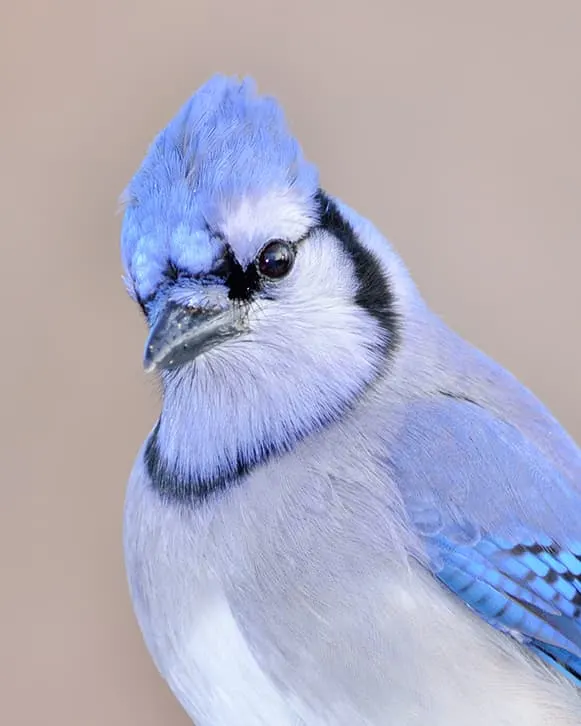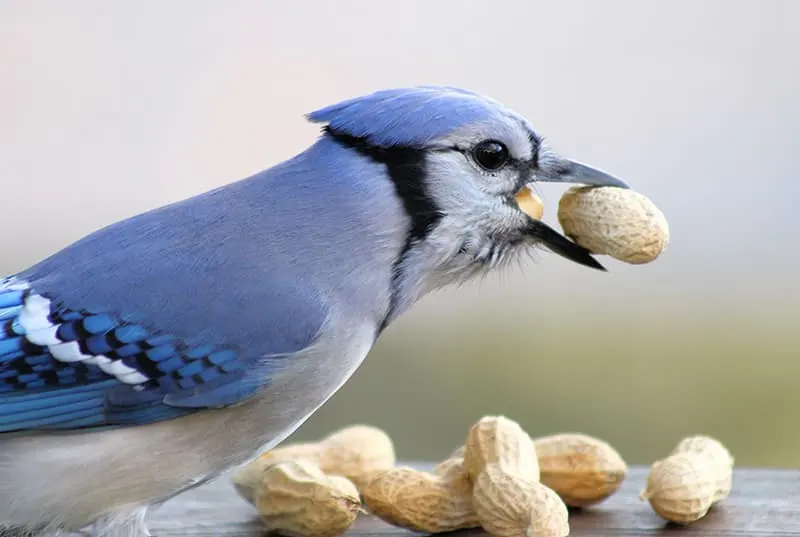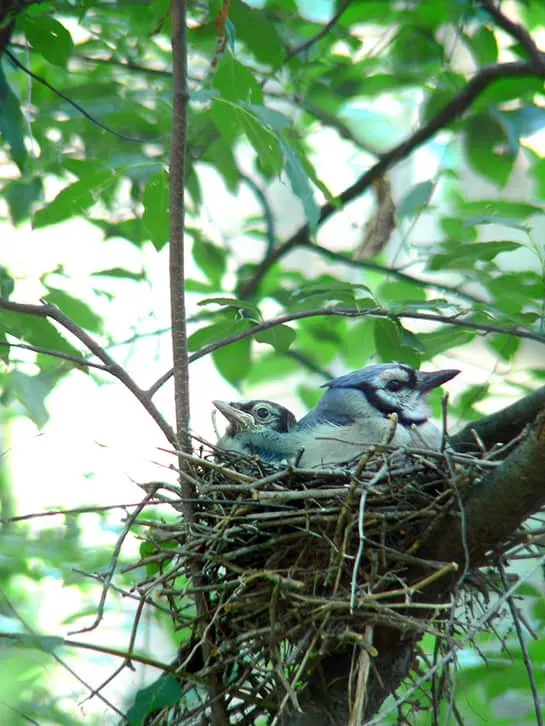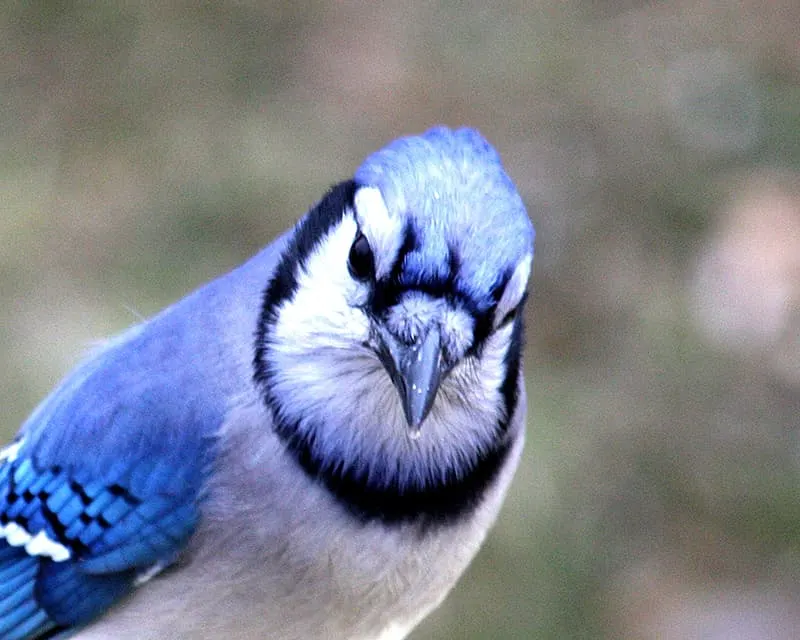Do you want to learn some interesting facts about blue jays? Learn all about blue jays in this post. We will be talking about their physical description, habitat, offspring, and more!

There are ten species of jay found in the United States and North America. Nine of these species are at least partially blue. These species of birds are commonly called “blue jays”. Two examples of these birds are the California scrub jay and Steller’s jay. You can read about the different kinds of jays here.
In this article, we will be talking about the actual species of blue jay. The blue jay is a common bird that many people recognize, but scientists don't fully understand.
Physical Description
A blue jay has bright blue feathers that cover its head and body. It has a blue crest on the top of its head. It has white feathers on its throat, chest, and belly. A blue jay’s face is light gray.
It has black markings that look like a necklace. There are black and white stripes on its wings and tail. The tail is patterned with blue and black lines. A blue jay’s eyes, bill, legs, and feet are all black.
The blue jay is nine to twelve inches long. The average adult blue jay weighs between two-and-a-half and three-and-a-half ounces. Female blue jays are smaller and shorter than male blue jays.
Habitat
Blue jays can be found throughout southern Canada. In the US, they can be found in states east of the Rocky Mountains all the way to southern Florida and Texas. They prefer to live in oak and beech woodlands, but blue jays live in many habitats.
Blue Jays can be found in both cities and suburbs. They commonly live in residential areas and parks with oak trees.
Habits
Blue jays are social creatures that gather in flocks. These groups are aggressive and territorial. They act as guards and make a loud call to communicate that there is a predator in the area.
People often hear the blue jay before they see it. Groups of blue jays will attack or drive predators out of their territory. For instance, a flock of blue jays may swarm a cat to drive it away from a nesting area. Blue jays will even chase other birds away from bird feeders.
Blue jays are good for the environment because they help spread seeds. They bury nuts and seeds to save and eat for another time. Blue jays don't always return to eat their stash of seeds. The seeds and nuts then grow into plants and trees.
Anting
Blue jays are one of the many birds that practice a ritual called “anting”. First, the blue jay spreads out its wings. Then the blue jay rubs the ants on the feathers of its outspread wings. This removes the formic acid from the ants. Formic acid makes the ants taste bitter. Once the acid is removed, the blue jay swallows its tasty snack!
Migration
We have observed flocks of blue jays migrating along the Atlantic and Great Lakes coastal areas. We don't understand blue jay migration because it is not consistent or predictable. Blue jay migration is random with no observable pattern.
Less than half of the blue jay population migrates south. If there is a population of blue jays in an area, only some will migrate. Blue jays migrate at different ages, but some blue jays never migrate. A blue jay that migrates one year won't necessarily migrate the next year. Scientists suspect that the reason a blue jay migrates is to find a better food source.

Diet
Blue jays are omnivores. Their diet includes a variety of things. They eat acorns, fruit, and insects. They will also eat small creatures like mice that are injured or dead. While they do eat eggs and baby birds, these do not make up much of their diet. Their diet is mostly vegetarian.
Offspring
The blue jay breeding season is from March through July. Male and female blue jays will participate in the courtship ritual as a group. They bow their heads and fluff their feathers to show off. After a male and female become a pair, they mate and build the nest together.
The male brings the materials for the nest to the female. The female uses mud to cement the building materials together for the nest. Blue jays build their nests about ten to twenty-five feet above the ground in the thick part of a tree.
The mother blue jay lays a clutch of three to seven eggs. The eggs are typically light blue with black spots. The female blue jay sits on the eggs while the male blue jay brings her food and protects her.
The eggs take about three weeks to hatch. Baby blue jays hatch with closed eyes and no feathers. The mother blue jay stays with the babies until they grow their feathers at about twelve days old.
When the babies develop feathers, parents begin leaving the nest in search of food to bring back to their young. The blue jay babies begin to leave the nest and explore the ground at about a month old.
At about three months old, the young blue jays start to practice flying near the nesting area. In the fall, juvenile blue jays become independent from their parents. Blue jays are fully grown at one year.
We believe that juvenile blue jays remain connected to their family group as part of the larger flock.

Classification/Taxonomy
Kingdom: Animalia
Phylum: Chordata
Class: Aves
Order: Passeriformes
Family: Corvidae
Genus: Cyanocitta
Scientific Name: Cyanocitta cristata
History
The blue jay belongs to the corvid family. This family is also known as the “crow family.” The corvid family existed twenty-five million years ago. Blue jays, like other birds, are avian dinosaurs. It is likely that blue jays adapted and evolved after dinosaurs became extinct.
Predators
Baby blue jays have many predators. Their predators include snakes, crows, racoons, and squirrels. The main predators of adult blue jays are raptors such as owls and falcons.
Blue jays are protected under the Migratory Bird Treaty Act. There has not been a notable decline in the blue jay population. Blue jays are thriving and are listed as “Least Concern” on the IUCN Red List.
Lifespan
Blue jays typically live about seven years in the wild. A blue jay that survives its first winter has a good chance of surviving for at least seven years. Blue jays in the wild can live up to seventeen years old. Blue jays in captivity can live up to twenty-six years old.

What Sound Does a Blue Jay Make?
Hear what a blue jay sounds like by clicking on this audio file.
25+ Interesting Facts about Blue Jays
- Blue jays eat nuts by holding the nut down with their feet and cracking open the shell with their beaks.
- Blue jays have several calls, such as squeaks, piping notes, clicks, and rattles.
- Blue jays can imitate the scream of a hawk.
- Blue jays molt each summer, losing and regrowing a few feathers at a time.
- Blue jays who don't migrate live longer.
- Migrating flocks of blue jays can be as large as 10,000.
- Blue jays don't need to migrate south for winter because they can survive in snowy areas.
- A flock of blue jays will “mob” hawks to drive them away from the nesting area.
- Female blue jays typically lay eggs once a year, but sometimes lay eggs twice a year.
- Baby blue jays are called hatchlings.
- Blue jays have a “gular pouch” in their throat that allows them to hold extra food until they store it.
- Parents of blue jays will continue to care for a baby that has been returned to the nest.
- Blue jay parents will continue to care for an egg that has been returned to a nest.
- Blue jays rarely abandon their nests, even if the nest has fallen to the ground.
- Blue jays usually stay with the same mate during their lifetimes.
- The blue jay's scientific name means “crested, blue-chattering bird.”
- Blue jays are smart and have good memories.
- Blue jays are one of the easier birds to identify while bird watching.
- Blue jays like to hang out in oak trees because acorns are one of their favorite foods.
- Female and male blue jays look the same, it is difficult to tell them apart.
- Blue jays can fly up to 25 miles per hour.
- Blue jays can solve problems using tools.
- Blue jays are only active during the day.
- Blue jays have been known to migrate to the northwest.
- The wingspan of a blue jay can be up to 17 inches across.
We hope you enjoyed learning all about blue jays! Did you learn anything new? Let us know any other facts you know about blue jays. We can’t wait to hear from you!
You don't want to miss learning about these cool birds.
